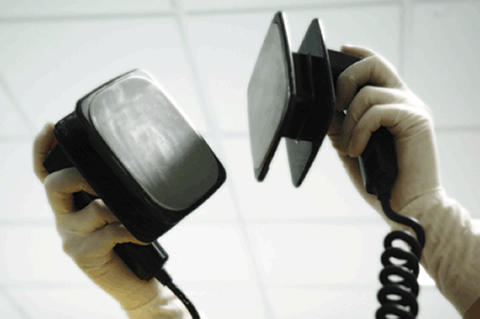Of the 40,000 cardiac arrests that occur annually in Canada, about 95 per cent result in death due to a lack of rapid treatment – often because there isn’t an automated external defibrillator (AED) nearby.
Now, a team of researchers that includes U of T faculty members has determined the optimal locations for public defibrillators in Toronto, based on where the most cardiac arrests occur.
Defibrillators are portable, easy-to-use electronic devices that provide bystanders with visual and audio instructions on how to electrically shock the heart of someone in cardiac arrest to restore an effective rhythm. When used with cardiopulmonary resuscitation (CPR), the machines can increase the likelihood of survival by 75 per cent.
However, for cardiac arrests that occur outside hospitals, defibrillators are used only three per cent of the time. The researchers want to tackle that problem by getting at its root: by ensuring that the 1,669 defibrillators registered with Toronto’s emergency medical services are located in the right spots.
“Where cardiac arrests are occurring is not where AEDs are. They’re not situated in the hot spots where people spend most of their time,” says Laurie Morrison, a professor of emergency medicine at U of T and an emergency medicine doctor at St. Michael’s Hospital.
From December 2005 to July 2010, Morrison and her U of T colleagues tracked the locations of the 1,310 cardiac arrests that occurred in public locations in Toronto and their proximity to registered defibrillators. Their research revealed that only 23 per cent of cardiac arrests occurred within 100 metres (the maximum recommended distance) of a defibrillator.
The researchers identified and mapped the top 30 locations in the city that had the most cardiac arrests and were not within 100 metres of a defibrillator. Most were in busy commercial areas with high levels of pedestrian and automotive traffic. About about half were downtown, and included intersections such as Queen and Bay streets and Jarvis and Gerrard streets. Using mathematical modelling, they determined that if defibrillators had been available in these 30 locations, they would have been optimally located to treat an additional 112 cardiac arrests.
Morrison acknowledges that defibrillator use during cardiac arrests is influenced by other factors: if more defibrillators were registered, emergency services could locate them quickly when needed; many are stored in inaccessible locations, and building staff don’t know where they are; and there are no government policies or guidelines on the optimal number and placement of most defibrillators. Finally bystanders tend to be reluctant to use them. The researchers say any initiative to promote public defibrillator use should include a public awareness campaign focusing on using the device in conjunction with CPR.
Morrison and co-researchers Timothy Chan and Steven Brooks are now continuing their research by studying how placing defibrillators in areas such as chain stores, bus stops and outdoor swimming pools would further improve the chances that one will be nearby for someone in need.
Ultimately, Morrison says, a data-driven approach to placing defibrillators is what’s needed to reduce the cardiac arrest death toll. “When we put AEDs in the right places, it can make a meaningful difference in terms of saving lives.”
Recent Posts
U of T’s 197th Birthday Quiz
Test your knowledge of all things U of T in honour of the university’s 197th anniversary on March 15!
Are Cold Plunges Good for You?
Research suggests they are, in three ways
Work Has Changed. So Have the Qualities of Good Leadership
Rapid shifts in everything from technology to employee expectations are pressuring leaders to constantly adapt







2 Responses to “ Help in a Heartbeat ”
When M.P. Scott Reid was first elected to Parliament he decided to use his FULL salary for projects in the riding. One of the projects was to pay for and install defibrillators in as many "public buildings" as possible-arenas, community centres, Legion buildings, swimming pools, curling rinks, etc. This quiet work has meant that this life saving device is available and has been used on numerous occasions, really saving lives. I don't know how many folks know of this work but in an age of self-seeking, greedy politicians I thought it might be nice for others, not in our constituency, to know of his decision.
An excellent article.
Many people given the opportunity to locate and use an AED may take too long to learn how to apply it. An ongoing television campaign would have significant impact in educating the public as to the operation of an AED thereby saving valuable time. The information should also have a visual demonstration for those that do not understand English. The general location of AEDs, such as the ones you have identified, should also be included in any presentation. The first action however should be to call 911 on a cell phone. Most people seem to carry one.
Perhaps the costs could be shared by the various levels of governments, the television networks, the manufacturers of the AEDs, the Heart and Stroke Foundation and the general public.
In the same commercial, there could be a demonstration on applying CPR. I'm sure these thoughts have been identified but hopefully there might be serious consideration to implementing them.